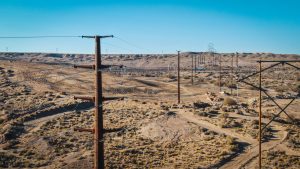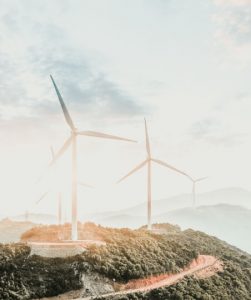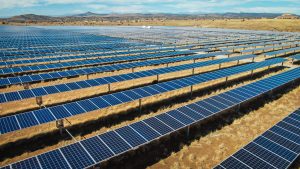
A generation interconnect (gen-tie) line is a series of poles, wires, cables, anchors and foundations connecting nearby power generation sites and substations. The system transmits an electrical current to a substation before the electrical grid in order to condition it for long-distance transmission to community power infrastructures.
Connecting Renewable Power Generation Sites to the Grid
The energy sector is adding commercial solar projects and wind sites at an accelerated rate, and these new renewable energy generation sites must connect with the grid’s transmission lines. The electrical grid transmits electricity to distribution systems at a voltage ranging from 100 kilovolts to 1,000 kilovolts. However, power plants produce an electrical current that ranges from 480 volts to 220 kilovolts.
Gen-tie lines enable renewable energy sites to direct low-voltage electricity to substations, where a step-up transformer elevates the current’s voltage to a transmittable level. This step prevents voltage loss during transmission, contributes to a renewable energy project’s feasibility and moderates consumer prices.
Gen-Tie Lines in Renewable Electricity Generation and Storage
Wind and solar energy generation facilities are two of the most prolific clean energy producers, and they are multiplying faster than most other sources. New gen-tie lines should accommodate their wind or solar plant’s wattage capacity, voltage level requirements and procurement fluctuations.
Wind
The average wind turbine can produce electricity at a capacity of 3.2 megawatts but is subject to weather-related fluctuations. Specific gen-tie systems resolve challenges unique to wind farms:
- Low voltage shutoff: Some gen-tie systems will shut down when the voltage dips below their threshold. Wind gen-ties must remain active when voltage declines or connect with a battery to rise above the threshold.
- Voltage loss: Offshore wind farms and those in remote locations are farther from substations. Increasing a gen-tie line’s wire length and thickness can preserve the current.
- Voltage spikes: The gen-tie line’s capacity must prepare for significant voltage spikes from extreme winds. A specially designed system will help ensure reduced damage and greater grid stability.
Solar
Capacity and voltage output at solar farms are predictable, especially in open fields and warm climates. The largest solar farms consistently offer a capacity greater than 200 megawatts. However, a solar farm will generate less energy than a fossil fuel plant of the same size.
Precise solar farm gen-tie planning can leverage predictable generation to control costs. The gen-tie should accommodate the solar farm’s output with an exact capacity for overage to maximize transmission efficiency.
A solar farm may also have unique length and thickness requirements for its gen-tie line. The distance between the solar farm and the substation may be greater than a typical gen-tie would accommodate. Customizing the system’s length and thickness will ensure efficient energy travel to the substation.
Batteries for Solar and Wind Systems
Renewable energy projects require solutions for a solar farm’s comparatively low output and a wind farm’s peaks and valleys. Connecting to a battery energy storage system (BESS) at the end of the gen-tie line helps renewable energy sites meet demand and maintain a safe, stable grid connection.
A BESS can gather and discharge electricity as needed. It fills by amassing excess high-voltage electricity from the transformer, then empties by discharging electricity into the transmission line.
Excess energy accumulates when power generation spikes occur at solar or wind plants. The BESS will also charge when decreased demand drops the amount of electricity needed.
A BESS discharge will occur when the voltage traveling through the gen-tie is too low. Operators may also discharge electricity from a BESS during a rise in demand to capitalize on higher consumption prices.
Increasing battery storage is a top priority in the energy sector as the United States seeks to improve sustainability. As BESS usage increases, renewable energy project developers must consider the relationship between the BESS and the gen-tie line. The gen-tie line’s design should facilitate the ideal parameters for active and reactive voltage adjustment according to the project’s specifications.
How Can SelectROW Help?
SelectROW oversees crucial land acquisition and project management procedures for the developers installing and maintaining gen-tie lines. We have extensive experience in title research, routing and siting, right-of-way acquisition, stakeholder engagement, and other critical procedures involved in accessing land for energy sector projects. Our knowledgeable real estate professionals and legal team will position your organization for a cost-efficient gen-tie line project.
Partner With SelectROW for Your Gen-Tie Line Project
SelectROW professionals advance significant transmission line projects in various parts of the United States, such as a 115-kilovolt transmission line that passes through property owned by Bernalillo County’s largest private owner. We will determine and execute a strategy that benefits your organization. Contact us online to discuss the land acquisition possibilities for your gen-tie line project.

